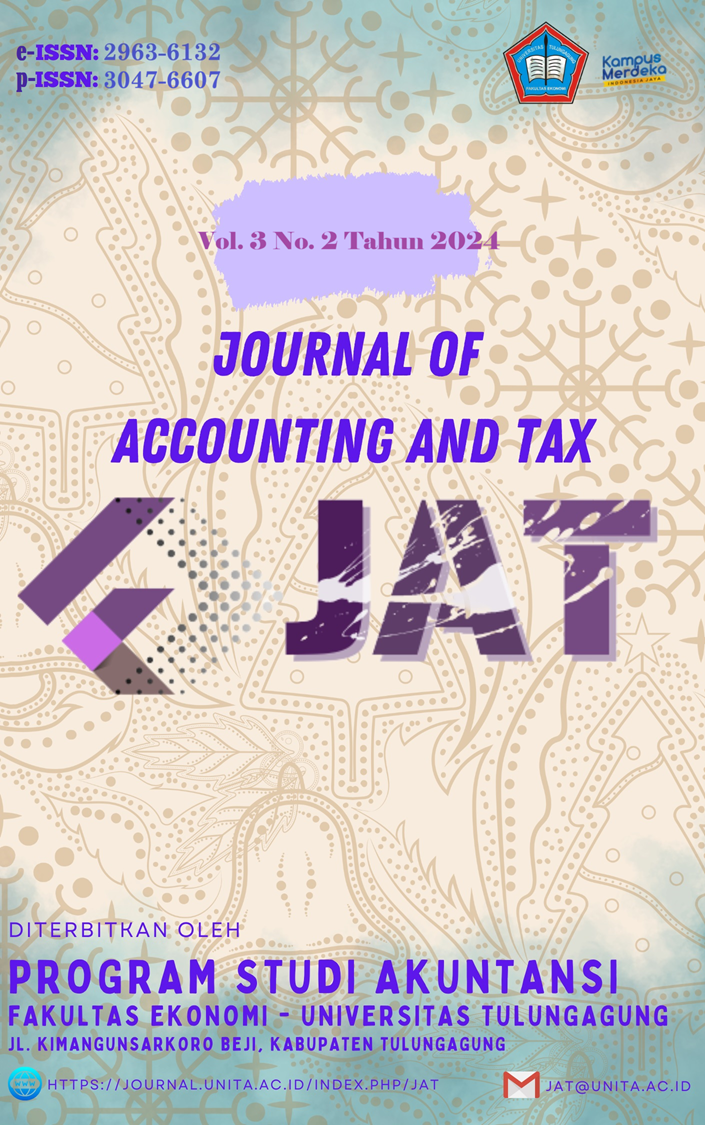ASSESSING THE ECONOMIZATION, EFFICIENCY AND EFFECTIVENESS OF HUMAN RESOURCES FUNCTIONS THROUGH MANAGEMENT AUDIT AT PILLAR MAS GROUP
DOI:
https://doi.org/10.36563/jat.v3i2.1247Keywords:
management audit, HR functionsAbstract
This study aims to assess the economy, efficiency, and effectiveness of HR functions and provide recommendations for various issues found at Pilar Mas Group. The HR functions examined include HR planning, HR recruitment, HR selection and placement, HR training and development, career planning and development, employee performance evaluation, compensation and rewards, occupational health and safety, employee job satisfaction, and termination of employment. The study employs a qualitative method with a descriptive qualitative approach. Data collection methods include observation, interviews, and documentation. Data analysis techniques involve categorizing audit findings based on elements of condition, criteria, cause, and effect. The results indicate that HR planning, selection and placement, career planning and development, and termination of employment are not yet operating economically, efficiently, and effectively. HR recruitment, training and development, performance evaluation, compensation and rewards, occupational health and safety, and employee job satisfaction are functioning economically, efficiently, and effectively.
Downloads
References
Al-Nakeeb, A. A. R., & Ghadi, M. Y. (2024). Human resource management practices for effective organizational change: A review of research in Western and non-Western countries. Foundations of Management, 16, 7–22. https://doi.org/10.2478/fman-2024-0001
Armstrong, M. (2021). Armstrong's Handbook of Strategic Human Resource Management (7th ed.). London: Kogan Page.
Badewin, Rosliana, and R. Melasari. (2022). Audit Manajemen: Petunjuk Bagi Praktisi. Ponorogo: Uwais Inspirasi Indonesia.
Bayangkara, I. (2015). Audit Manajemen: Prosedur Dan Implementasi, Edisi Kedua. Jakarta: Salemba Empat.
Boxall, P., Purcell, J., & Wright, P. (2007). The Oxford Handbook of Human Resource Management. Oxford: Oxford University Press.
Callaghan, C. W., & Papageorgiou, E. (2019). The use of human resources literature regarding the relationship between affect and student academic performance. SA Journal of Human Resource Management, 17, Article a1111. https://doi.org/10.4102/sajhrm.v17i0.1111
Collins, C. J. (2021). Expanding the resource-based view model of strategic human resource management. The International Journal of Human Resource Management, 32(2), 331–358. https://doi.org/10.1080/09585192.2019.1711442
Decramer, A., Smolders, C., & Vanderstraeten, A. (2020). Employee performance management culture and system features in higher education: Relationship with employee performance management satisfaction. The International Journal of Human Resource Management, 31(5), 620–646. https://doi.org/10.1080/09585192.2017.1365706
Dessler, G. (2020). Human Resource Management (16th ed.). Upper Saddle River, NJ: Pearson Education.
Fiantika, F.R. et al. (2022). Metodologi Penelitian Kualitatif. Sumatera Barat: PT. Global Eksekutif Teknologi.
Mathis, R. L., Jackson, J. H., Valentine, S. R., & Meglich, P. A. (2019). Human Resource Management (15th ed.). Boston, MA: Cengage Learning.
Meijerink, J. G., Beijer, S. E., & Bos-Nehles, A. C. (2021). A meta-analysis of mediating mechanisms between employee reports of human resource management and employee performance: Different pathways for descriptive and evaluative reports? The International Journal of Human Resource Management, 32(2), 394–442. https://doi.org/10.1080/09585192.2020.1810737
Otoo, F. N. K. (2019). Human resource development (HRD) practices and banking industry effectiveness: The mediating role of employee competencies. European Journal of Training and Development, 43(3/4), 250–271. https://doi.org/10.1108/EJTD-08-2018-0086
Piwowar-Sulej, K. (2022). Sustainability in the development of human resources. Sustainable Development, 30(1), 219–230. https://doi.org/10.1002/sd.2135
Saputra, R.M.I., Novriyanti, & Triyono, A. (2022). Perencanaan Dan Audit Sumber Daya Manusia. Purbalingga: Eureka Media Aksara.
Sihombing, S., Gultom, R. S., & Sidjabat, S. (2015). Manajemen Sumber Daya Manusia, Edisi Revisi. Bogor: Penerbit IN MEDIA.
Subramony, M., & Pugh, S. D. (2019). Services management research: Review, integration, and future directions. Journal of Management, 45(1), 254–286. https://doi.org/10.1177/0149206318799703
Torrington, D., Hall, L., Taylor, S., & Atkinson, C. (2020). Human Resource Management (10th ed.). London: Pearson Education.
Van Beurden, J., Van De Voorde, K., & Van Veldhoven, M. (2021). The employee perspective on HR practices: A systematic literature review, integration, and outlook. The International Journal of Human Resource Management, 32(2), 356–393. https://doi.org/10.1080/09585192.2020.1759671
Wafy, D. J. I., & Deka, A. (2024). The impact of human resource management practices on employee performance: A systematic review. Journal of Human Resource Management, 27(1), 98–108.
Downloads
Published
Issue
Section
License
Authors who publish with this journal agree to the following terms:
- Copyright on any article is retained by the author(s).
- The author grants the journal, right of first publication with the work simultaneously licensed under a Creative Commons Attribution License that allows others to share the work with an acknowledgment of the work’s authorship and initial publication in this journal.
- Authors are able to enter into separate, additional contractual arrangements for the non-exclusive distribution of the journal’s published version of the work (e.g., post it to an institutional repository or publish it in a book), with an acknowledgment of its initial publication in this journal.
- Authors are permitted and encouraged to post their work online (e.g., in institutional repositories or on their website) prior to and during the submission process, as it can lead to productive exchanges, as well as earlier and greater citation of published work.
- The article and any associated published material is distributed under the Creative Commons Attribution-ShareAlike 4.0 International License
Deprecated: json_decode(): Passing null to parameter #1 ($json) of type string is deprecated in /home/journal.unita.ac.id/public_html/plugins/generic/citations/CitationsPlugin.php on line 68


_.jpg)




